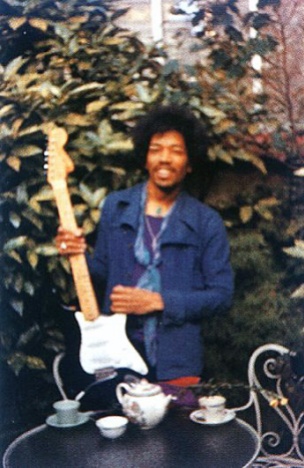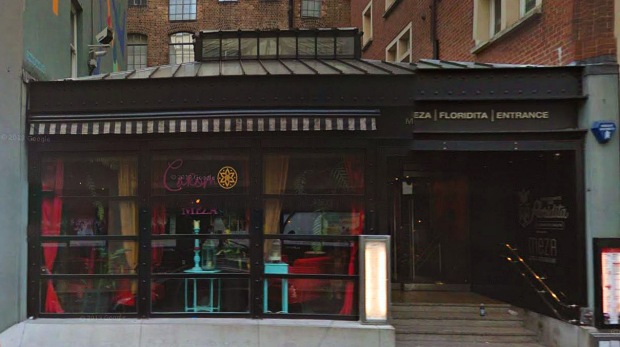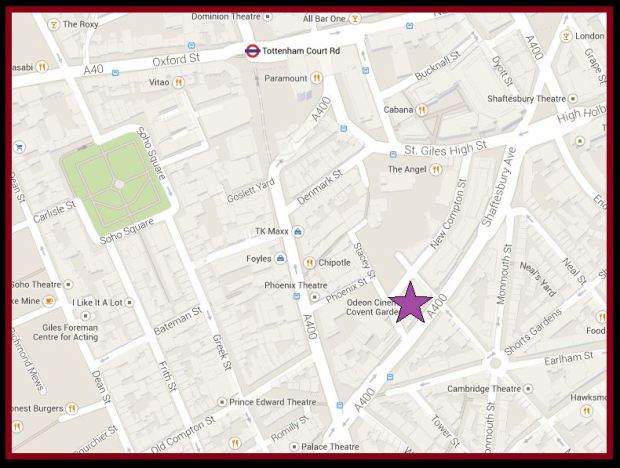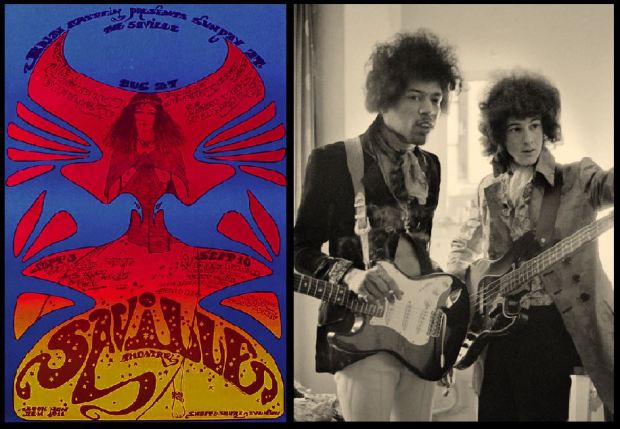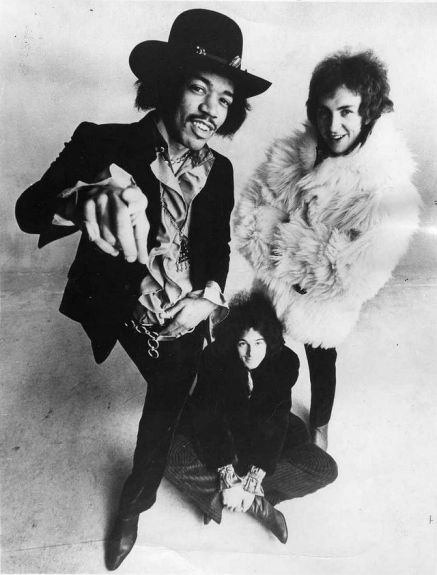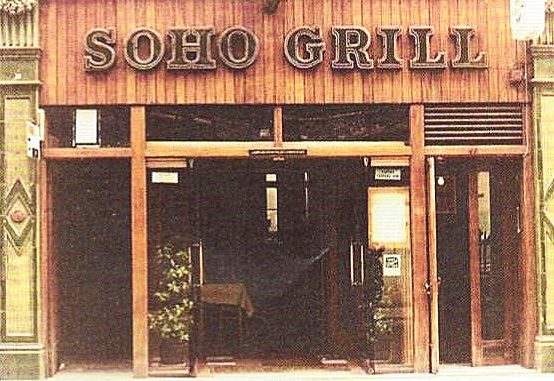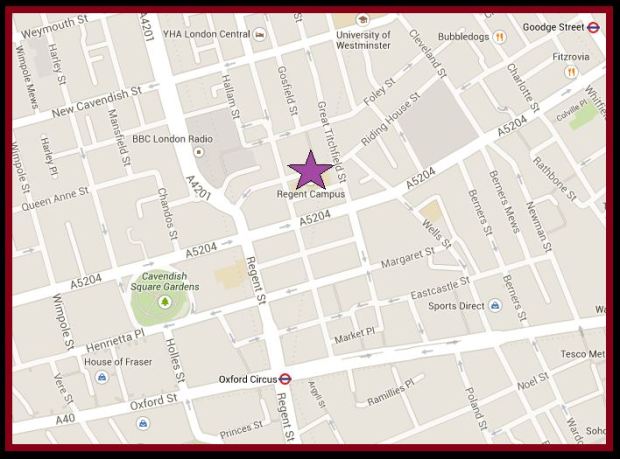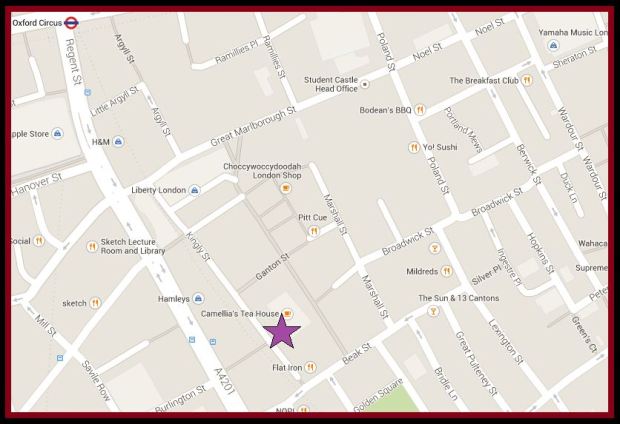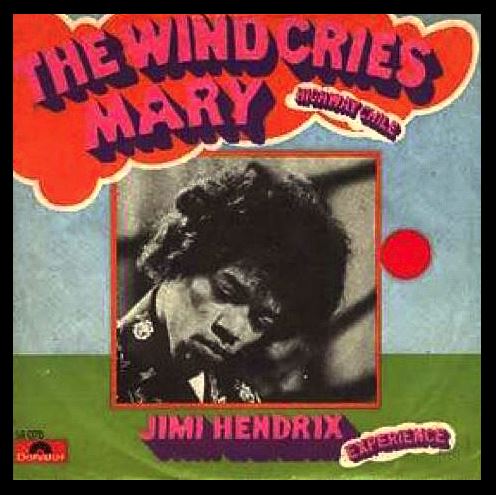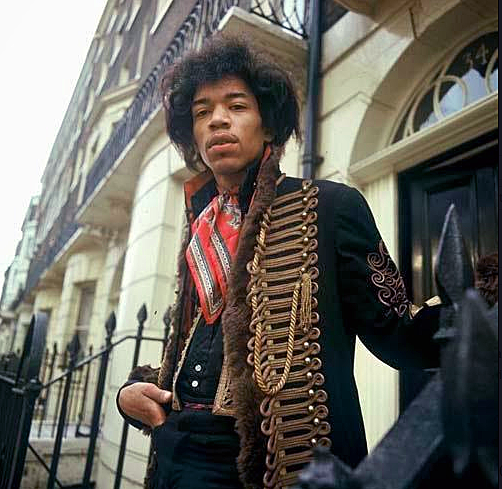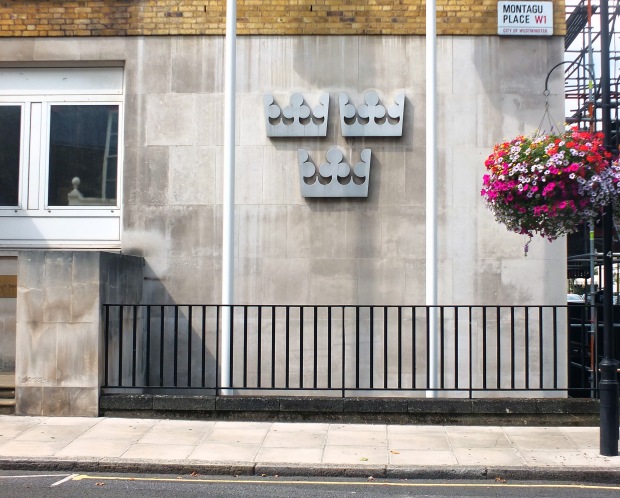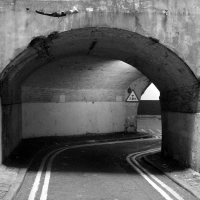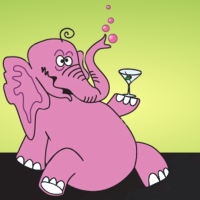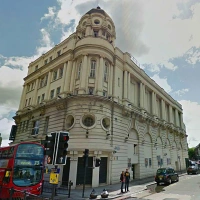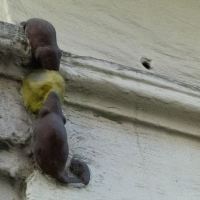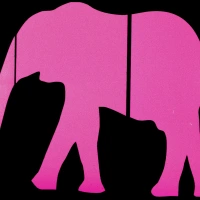Jimi Hendrix’s London (Part Three)
The final installment in our tour of Jimi Hendrix’s London.
23 Brook Street, W1
After an extensive tour of the USA, Jimi Hendrix returned to London in the summer of 1968 with the intention of making the city his main base.
In anticipation of his return, Jimi’s partner, Kathy Etchingham secured a flat on the top two floors of 23 Brook Street, Mayfair moments away from the American embassy on Grosvenor Square.
The cosy apartment was priced at £30 a week (£450 in today’s money) and shortly after moving in, Jimi and Kathy popped into the John Lewis department store on nearby Oxford Street to pick furnishings for their flat.
Jimi Hendrix settled quickly into his Mayfair digs, warmly describing the apartment as “my first real home of my own.”
As well as providing a home, the Brook Street address was also used for business with interviews and rehearsals (complete with a full drum kit and beefy amplifiers) taking place here.
A camp bed was also kept handy for the numerous musicians wishing to sleep over at Jimi and Kathy’s place- George Harrison was one such guest.
When Jimi Hendrix first came to 23 Brook Street, he was intrigued to discover that another musician- mighty baroque composer, George Frideric Handel– had once lived next door at number 25.
Born in Germany in 1685, Handel moved to London in 1710 in order to provide his musical talents to the royal court and became so enamoured with England that he decided to settle permanently.
The composer moved to Brook Street in 1723 and remained there until his death in 1759. His epic masterpiece, The Messiah was composed at the address.
Handel also did a great deal for charity, becoming one of the greatest benefactors of the Foundling Hospital for Children.
After discovering his long departed musical neighbour, Jimi went out to buy the full set of Handel’s work on vinyl (his favourite record shops being the One Stop Music Shop on South Molton Street, and Oxford Street’s HMV) and according to some musical experts, it is possible to spot Handel-like influences in Hendrix’s work…
In 2001, 25 Brook Street was restored to look as it did during Handel’s time and is now open to the public as the Handel House Museum.
Jimi’s address, number 23, has been conjoined to number 25 for many years and currently provides office space.
However, following a £1.2 million grant from the Heritage Lottery Fund, Jimi’s digs will soon also be opened as a museum (expected to be unveiled in 2015).
If you cannot wait until then to see inside his old home, a sneak-peak can be viewed here courtesy of the BBC and a blog on the project’s progress can be read here.
*
BBC Television Centre (now closed), Wood Lane W12
On the 4th January 1969 The Jimi Hendrix Experience were invited to the iconic Shepherd’s Bush building to record a session for Happening with Lulu; a live T.V variety show hosted by, as the name suggested, Scottish singer and 1960s icon, Lulu.
As the band set up they were told by the show’s producers that Lulu would be joining them at the end of the set to perform her hit, ‘To Sir with Love‘… and that Jimi would be expected to sing with her.
Although a perfectly decent song in its own right, anyone familiar with the works of Jimi Hendrix would know all too well that Lulu’s tune (used in the 1967 Sidney Poitier film of the same name) is the polar opposite in style to Hendrix’s brand of bluesy, psychedelic rock.
Unsurprisingly, the band decided amongst themselves that such a duet would look rather embarrassing … and so came up with a cunning plan to make sure it didn’t get a chance to happen…
After playing their scheduled set of Voodoo Child and Hey Joe, Jimi went off road, butting in with the words, “we’re gonna’ stop playing this rubbish and dedicate a song to the Cream… I’d like to dedicate this to Eric Clapton, Ginger Baker and Jack Bruce.”
Jimi, Noel and Mitch then launched into an electrifying rendition of, Sunshine of Your Love.
This cheeky improvisation nudged the show into the 6 o’clock news slot, forcing producers to pull Lulu’s show off air. Footage of the incident, which was saved by BBC engineer, Bob Pratt can be viewed below (please click to watch):
Ever the gentleman, Jimi apologized to Lulu after the show… who didn’t mind at all, saying it made “great telly,” and invited Jimi around to her flat (shared with her then partner, Maurice Gibb) later that night… although the stunt did result in Jimi Hendrix being banned from performing live on the BBC again!
*
The Royal Albert Hall, Kensington Gore, SW7
The Jimi Hendrix Experience played two of their most celebrated gigs at this landmark venue on February 18th and 24th 1969, the recordings of which have become much sought after by fans.
*
The Cumberland Hotel, Great Cumberland Place W1
Named after the Duke of Cumberland pub which once stood on the site, the huge, art-deco Cumberland Hotel first opened in the 1930s and today remains one of London’s largest and most frequented hotels.
After attending the Isle of Fehmarn Festival in Germany (at which the Experience’s appearance was frustratingly cancelled due to torrential rain and the risk of electrocution), Jimi returned to London and checked into the Cumberland Hotel on the 6th September 1970.
Over the next twelve days, Jimi stayed on and off at the Cumberland, using his room more as a crash pad rather than an established home.
His final interviews were recorded at the hotel on 11th September for the BBC’s, ‘Scene and Heard’, and with music journalist, Keith Altham for ‘Record Mirror‘.
Today, the Cumberland (which sadly appeared on Jimi’s death certificate as his last official address) boasts its very own Hendrix suite which has been decked out in a colourful 1960s style.
*
Ronnie Scott’s, 47 Frith Street W1
This highly acclaimed jazz club first opened on Gerrard Street in October 1959 and transferred to its present Soho site in 1965. It was here, in 1969 that The Who premiered their concept rock opera, Tommy.
Jimi Hendrix came to Ronnie Scott’s on the night of the 16th September 1970 and jammed with American funk band, Eric Burdon & War.
It would be the last ever time Jimi performed live on stage and his performance was uncharacteristically subdued.
According to close friend and Rolling Stones guitarist, Ronnie Wood, Jimi Hendrix “looked really sad” as he left the club, and also noted that it was the first time Jimi never bade his audience ‘good-night’.
Ronnie Wood also said that, over the years, Jimi “didn’t realise how good he was” and would have frequent doubts about the quality of his singing voice, despite assurances from his friends.
*
The Samarkand Hotel, 21-22 Lansdowne Crescent W11
By September 1970, Jimi Hendrix was in a new relationship with Monika Dannemann, a German artist and figure-skater who was renting accommodation at the Samarkand; a self-catering apartment hotel in the heart of Notting Hill.
As autumn approached, Jimi was overworked and suffering from exhaustion and with numerous problems playing on his mind he was also finding it difficult to sleep.
On the 17th September 1970 Jimi and Monika spent the day together, visiting the King’s Road, the Cumberland Hotel and the now vanished Kensington Market.

The former Kensington Market which remained a popular venue with young music lovers until the 1990s (image: Wikipedia)
That afternoon, whilst drinking tea in the garden of the Samarkand Hotel, Jimi posed for photographs- the last which would ever be taken of him.
Later that night, Jimi and Monika attended a party and returned to the Samarkand sometime after 3am.
*
The following morning at around 11am Monika awoke to find Jimi sleeping but unresponsive. Panicked, she called for an ambulance and when the crew arrived they found Jimi Hendrix covered in vomit, “his airway completely blocked all the way down.”
*
St Mary Abbot’s Hospital (closed in 1993 & now Kensington Green gated apartments), Marloes Road W8
Jimi Hendrix was rushed to St Mary Abbot’s Hospital in Kensington, less than two miles from the Samarkand Hotel. The ambulance arrived at 11.45am and Jimi was immediately taken to the resuscitation room where Dr Martin Seifert fought for thirty minutes to revive him.
But it was of no use, Jimi was already long gone and he was pronounced dead at 12.45pm.
He was 27 years old.
*
In the 1990s Jimi’s former girlfriend, Kathy Etchingham led a campaign to secure the guitar legend a blue plaque– the one which now adorns 23 Brook Street.
The plaque was unveiled in 1997.
*
Just hours before he died, Jimi Hendrix picked up pen and paper to jot down some lyrics; something he often did when restless and unable to sleep.
His final song, written in those fateful early hours of the 18th September 1970 in Notting Hill, was entitled The Story of Life,the closing lyrics of which make an appropriate epitaph:
“The story of life is quicker than the wink of an eye, the story of love is hello and goodbye,
Until we meet again”…
Jimi Hendrix’s London (Part One)
Incredibly, it is almost fifty years since legendary musician, Jimi Hendrix’s sublime guitar skills became known to the world.
Born in Seattle, Washington on November 27th 1942, Jimi Hendrix obtained his first guitar- an acoustic model costing a mere $5- when he was fifteen years old.
In 1961 he enlisted in the army where he trained to be a paratrooper.
Military life wasn’t for Private Hendrix- perhaps most clearly demonstrated when he was caught dozing whilst on duty!
He was discharged in 1962 and, eager to forge a career in music, began touring clubs across the United States.
Over the next few years Jimi perfected his craft but despite his talent, he struggled to make a wage, remaining undiscovered and creatively stifled.
His luck changed in May 1966 whilst playing at the Cheetah club in New York.
Here he was spotted by Linda Keith– girlfriend of the Rolling Stones’ Keith Richards– who recommended the dazzling guitarist to Chas Chandler– former bassist for The Animals who was looking to establish himself as a manager.
Like Linda, Chas Chandler could see that Jimi Hendrix was indeed a very rare talent… and so decided to whisk him to London which, during the swinging 60s, was the place where Jimi Hendrix would flourish and make his name.
Tragically, it was also the city in which he would lose his life.
*
In tribute to Jimi Hendrix and to celebrate the exciting announcement that one of his former London homes will soon be opening to the public as a museum, I have compiled a list of some of the most notable London locations associated with the late, great performer…
*
11 Gunterstone Road, W14
Jimi Hendrix first arrived in London on 24th September 1966, flying into London Airport (which officially changed its name to ‘Heathrow’ that same year).
After several years as a struggling musician, Jimi Hendrix had very little to his name. When he boarded the plane in New York his only possessions were a change of clothes, a set of hair curlers, $40 (which he’d borrowed) and of course his beloved guitar.
Upon his arrival in London, Jimi was taken straight from the airport to 11 Gunterstone Road, West Kensington which was the home of British musician, Zoot Money, a major figure on the Soho scene at the time.
Whilst at the house, Jimi took part in a jamming session with Zoot’s friend, Andy Summers– who would later go on to play with The Police.
*
Scotch of St James Club, 13 Mason’s Yard W1
On the evening of 24th September 1966, Jimi Hendrix played his first ever UK solo gig at the exclusive Scotch of St James club in Mason’s Yard; a peaceful courtyard which is now dominated by the White Cube modern art gallery.
A stone’s throw from Buckingham Palace, the club was popular with The Rolling Stones and The Beatles, both of whom enjoyed the luxury of their own private tables. The Who and Stevie Wonder also spent time here.
Immediately after his set, Jimi met Kathy Etchingham and the pair embarked upon a two year relationship.
The following month, Hendrix returned to Scotch of St James with musicians Mitch Mitchell and Noel Redding, who together formed The Jimi Hendrix Experience and thus it was here that the trio performed their UK debut.
*
Les Cousins Club (now Club 49), 49 Greek Street W1
Originally opened in the 1950s as the ‘Skiffle Cellar’, Les Cousins (tucked away beneath the Soho Grill) was at the heart of London’s folk scene by the 1960s
After just a few days in London, Jimi Hendrix and Chas Chandler paid a visit to the club as regular guests, paying their own entry fee.
Blues musician, Alexis Korner was on stage that night and Chas Chandler asked if Jimi could join him on stage for a jamming session… needless to say the crowd were gobsmacked by the young American’s flair!
*
Westminster Polytechnic (now Westminster University, Regent Campus), Little Titchfield Street
On the evening of 1st October 1966, Cream were playing at this London Polytechnic campus when Jimi Hendrix rather audaciously asked if he could get up and jam with Eric Clapton, the UK’s undisputed guitar king.
Jimi’s skill and flamboyant style knocked Eric Clapton for six and, once back stage the Cream guitarist had to ask Chas Chandler if the American was ‘always that good?’!
Despite their guitar duel, Eric Clapton and Jimi Hendrix became firm friends.
*
Cromwellian Club (now gone), 3 Cromwell Road, SW7
Situated directly opposite the Natural History Museum, the Cromwellian Club was rumoured to have started life as an illegal gambling den.
By the 1960s, ‘The Crom’ as it was nicknamed had established itself as a popular casino and music venue, witnessing performances from the likes of Georgie Fame, Eric Clapton and a very young Elton John.
Jimi Hendrix played one of his earliest gigs here in October 1966.
*
Bag O’ Nails Club, 9 Kingly Street W1
The Jimi Hendrix Experience played a gig at the Bag O’Nails club on 25th November 1966, after which, Jimi remarked, “Britain is really groovy”- not a surprising observation considering the club backs onto the ultra-hip Carnaby Street.
At another Bag O’Nails gig on 11th January 1967, Paul McCartney and Ringo Starr were in the audience… it was the first time they’d seen Jimi play live and, naturally, they were entranced.
Later that year, Paul McCartney met his future wife, Linda at the club.
*
Blaises Club (now gone) 121 Queen’s Gate SW7
Located in the basement of the now demolished Imperial Hotel, Blaises (named after the cartoon character, Modesty Blaise) was a cramped, sweaty club which, according to Melody Maker journalist, Chris Welch, was a venue, “where musicians, agents, managers and writers allowed themselves to be deafened whilst imbibing quantities of alcohol.”
Jimi Hendrix appeared here on 21st December 1966 which led to one of first rave reviews: “Jimi has great stage presence and an exceptional guitar technique which involved playing with teeth on occasions and no hands at all on others!” (tricks which he’d learnt from old timers whilst on the US circuit).
Pink Floyd were another big name to appear at Blaises and the club can be seen in the cult 1967 film, The Sorcerers (in which Boris Karloff uses hypnosis to seriously mess up one cool cat’s mind!)
Please click below to view a clip of the Blaises club in its heyday:
*
34 Montague Square, W1
During the 1960s, the basement of this rather grand address was leased by Ringo Starr.
Consequently, the home has numerous connections with The Beatles– the song, ‘Eleanor Rigby‘ was developed here for example and in 1968 the racy cover for John Lennon and Yoko Ono’s, Two Virgins album was snapped on the premises.
Jimi Hendrix rented the basement from Ringo between December 1966 and March 1967, moving in with his girlfriend, Kathy Etchingham. Whilst at the address, Jimi composed ‘The Wind Cries Mary’.
Unfortunately Ringo had no option but to evict Jimi Hendrix when the guitarist, whilst under the influence of LSD, splashed paint all over the walls…
One of the most iconic photographs of Jimi was taken just across the road on Montagu Place outside the Swedish embassy. Sadly, the original street sign has since been removed.
*
Lime Grove Studios (now gone), W12
Between 1940 and 1991, Lime Grove in Shepherd’s bush was home to a BBC studio where many classic shows including Top of the Pops, Blue Peter, Doctor Who and a 1954 adaptation of George Orwell’s, 1984 (performed live and starring Peter Cushing) were filmed.
The Jimi Hendrix Experience filmed their first appearance for Top of the Pops here on 29th December 1966 with a performance of ‘Hey Joe’. Their next shoot took place on 30th March 1967– and can be viewed below.
Sadly, Lime Grove studios were demolished in 1993 and a modern housing development now occupies the site.
*
The Upper Cut Club (now gone), 1-39 Woodgrange Road, E7
Out beyond Stratford and past the former 2012 Olympic Park, this is probably the furthest east Jimi Hendrix ever ventured whilst in London!
Based in Forest Gate, the Upper Cut Club was in business for just one year between 1966 and 1967. Despite its short span, the club shone bright playing host to such greats as The Who, Otis Redding, Sam and Dave, Prince Buster, Ben. E. King and Nina Simone.
The Jimi Hendrix Experience appeared at the Upper Cut on Boxing Day, 1966…and it was here, whilst resting in the club’s dressing room, that Jimi penned Purple Haze, one of his most definitive hits.
A simple plaque now marks the site.
*
The Speakeasy Club (now gone), 48 Margaret Street, W1
Opened in 1966 a short distance from the bustle of Oxford Circus, the Speakeasy modelled itself on the illegal drinking dens which flourished during the era of American prohibition.
Visitors entered and signed in via a fake undertaker’s parlour… and were then permitted to enter the main club through a false wardrobe door! Inside, a menacing portrait of Al Capone loomed over the patrons.
This was one of Jimi Hendrix’s favourite London clubs and he could often be spotted hanging out with friends here.
Jimi’s first Speakeasy gig took place in February 1967… and it was here that he cheekily tried to chat up Mick Jagger’s then girlfriend, Marianne Faithful!
































